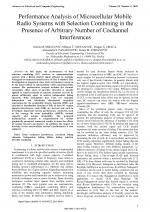| 4/2010 - 1 | View TOC | « Previous Article | Next Article » |
| Extra paper information in |
| Click to see author's profile in |
| Download PDF |
Author keywords
cochannel interference, correlated fading channels, Nakagami-m fading, Rician fading, selection diversity combining
References keywords
fading(15), channels(13), selection(9), correlated(9), stefanovic(8), radio(8), interference(8), cochannel(8), analysis(8), rician(7)
Blue keywords are present in both the references section and the paper title.
About this article
Date of Publication: 2010-11-30
Volume 10, Issue 4, Year 2010, On page(s): 3 - 8
ISSN: 1582-7445, e-ISSN: 1844-7600
Digital Object Identifier: 10.4316/AECE.2010.04001
Web of Science Accession Number: 000284782700001
SCOPUS ID: 78649715860
Abstract
In this paper, the performance of dual selection combining (SC) receiver in communications systems with a Rician desired signal affected by multiple Nakagami-m cochannel interferences (CCIs) is studied. This investigation is important since such environment seems to be the most realistic in microcellular radio communications systems. The performance analysis includes the channel correlation effect since in practice diversity is usually applied in small terminals so antenna elements can not be placed sufficiently apart to achieve independent fading channels. With assumption that CCIs are mutually independent and identically distributed, analytical expressions for the probability density function (PDF) and cumulative distribution function (CDF) of dual SC output signal-to-interference ratio (SIR) are derived and used to investigate important system performance measures, such as the average bit error probability (ABEP), channel capacity and outage probability. The proposed mathematical analysis is complemented by various graphically presented numerical results to show the effects of various system's parameters. In addition, the impact of diversity to the microcellular system's performance is also explored. |
| References | | | Cited By |
Web of Science® Times Cited: 1 [View]
View record in Web of Science® [View]
View Related Records® [View]
Updated today
SCOPUS® Times Cited: 2
View record in SCOPUS® [Free preview]
View citations in SCOPUS® [Free preview]
[1] Multiple co-channel interferers effect on system performances in Ricean fading channels, Krstić, Dragana, Panić, Stefan, Stamenović, Goran, Radenković, Dragan, Proceedings of the 3rd International Conference on Information and Communication Systems, ISBN 9781450313278, 2012.
Digital Object Identifier: 10.1145/2222444.2222463 [CrossRef]
Disclaimer: All information displayed above was retrieved by using remote connections to respective databases. For the best user experience, we update all data by using background processes, and use caches in order to reduce the load on the servers we retrieve the information from. As we have no control on the availability of the database servers and sometimes the Internet connectivity may be affected, we do not guarantee the information is correct or complete. For the most accurate data, please always consult the database sites directly. Some external links require authentication or an institutional subscription.
Web of Science® is a registered trademark of Clarivate Analytics, Scopus® is a registered trademark of Elsevier B.V., other product names, company names, brand names, trademarks and logos are the property of their respective owners.
Faculty of Electrical Engineering and Computer Science
Stefan cel Mare University of Suceava, Romania
All rights reserved: Advances in Electrical and Computer Engineering is a registered trademark of the Stefan cel Mare University of Suceava. No part of this publication may be reproduced, stored in a retrieval system, photocopied, recorded or archived, without the written permission from the Editor. When authors submit their papers for publication, they agree that the copyright for their article be transferred to the Faculty of Electrical Engineering and Computer Science, Stefan cel Mare University of Suceava, Romania, if and only if the articles are accepted for publication. The copyright covers the exclusive rights to reproduce and distribute the article, including reprints and translations.
Permission for other use: The copyright owner's consent does not extend to copying for general distribution, for promotion, for creating new works, or for resale. Specific written permission must be obtained from the Editor for such copying. Direct linking to files hosted on this website is strictly prohibited.
Disclaimer: Whilst every effort is made by the publishers and editorial board to see that no inaccurate or misleading data, opinions or statements appear in this journal, they wish to make it clear that all information and opinions formulated in the articles, as well as linguistic accuracy, are the sole responsibility of the author.



